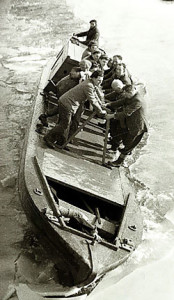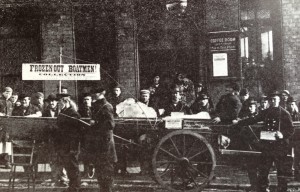Summer is the time when most boaters take to the water, enjoying long days and hopefully, warm sunny weather. But it should never be forgotten that the canals were originally built as a commercial transport network, and as such needed to be kept open all year round.

An Icebreaker on the canal
Even boaters, who have suffered the inconvenience of having their own boat frozen in on a canal, can scarcely believe the trouble and difficulties a harsh winter could bring boat operators a few decades ago.
If the canal had frozen to a point where the working boats could no longer navigate, the ice breaker boats would be called out. Unlike the traditional long narrowboat, icebreakers were general shorter and more stout and constructed from iron (or at least have their wooden hull covered and reinforced with metal).
The crew (often up to 20 men) would stand, holding onto a longitudinal rail running the length of the boat and, as a team of horses heaved away, would rock the boat quite violently from side to side to break through the ice.
The problem of freezing was compounded by locks. Lock Keepers were tasked with breaking up the largest lumps of ice that would form behind the lock gates, stopping them from opening – failure to prevent this would cause that section of the canal to become un-navigable – and everyone would then have to wait for the ice to thaw.
Many boat operators were only paid on a job by job basis, with no retaining wage to support their families in times of hardship, and owner-operators – the ‘Number 1’s’ would have no money at all. In these circumstances, their only recourse would be to take to the streets and beg. A bad winter could see entire boating communities reduced to the point of destitution.
Regrettably, the vulnerability of the canal network to the vagaries of the weather was to help lead to the decline of the canal network as the principal method of carrying freight in the UK. Goods, particularly perishable items that needed to reach their destination within a specified period would simply rot and become unusable. The very speculators who had enjoyed such success when ‘canal mania’ swept the UK, now turned their attention to the next great mode of transport emerging across Britain – The Railways.
Many canal owning railway companies found it easier to allow their waterways assets to decline, rather than persist in a programme of maintenance – Warehouse and wharves were allowed to fall into disrepair, and the canal started to look like the railways’ poor relation.
A large number of well established canal businesses found themselves under continuing threat from the burgeoning rail and latterly road operators, and it was inevitable that the decline would lead to the eventual closure of many canals around the country. Some Canal Companies responded by putting up tolls to use their waterways, but this only helped to escalate the problem. It was not until the growth of the canal network for leisure use, that some of the decline was to halt – but that is the subject of another article…


The big freeze of 1962/3 was just the last straw in what was already a dying trade